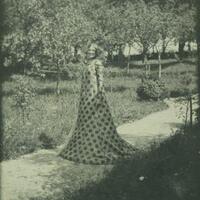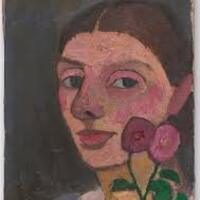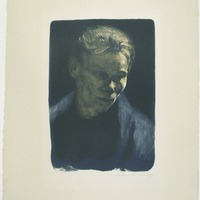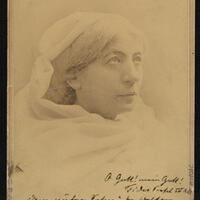Female Artists of the Gilded Age
All of the artwork featured in this portion of the collection was created by a female artist, shining a spotlight on select, underrepresented talent of the day. During the Gilded Age, women were not afforded the same legal protections as men; the right to vote was not extended to include womem until 1920, nearly 100 years after the suffrage movement first began (around 1840).
Emilie Louise Flöge
Emilie Louise Flöge (30 August 1874 – 26 May 1952) was an Austrian fashion designer and businesswoman. In collaboration with her sister Helene, Flöge established herself as a successful businesswoman and the owner of the haute couture fashion salon known as Schwestern Flöge (Flöge Sisters) in the Mariahilfer Strasse, a famous shopping area in Vienna. Schwestern Flöge were known for their loose, patterned dresses in the 'reform style.' The designer is wearing one of these dresses in this photograph. Victorian dress reform styles were promoted by the Viennese feminist movement and characterized by high bodices, a loose silhouette, and billowing sleeves; it was believed that these styles were better for women's health and allowed for greater range of motion. The painter Gustav Klimt, photographer of the image shown, was her life companion.
Paula Modersohn-Becker
Paula Modersohn-Becker (8 February 1876 – 20 November 1907) was a German Expressionist painter of the late 19th and early 20th century most known for her many self-portraits, including nude self-portraits. She is recognized both as the first known female painter to paint nude self-portraits, and considered to be the first woman artist to depict herself both pregnant and nude and pregnant. Many consider Modersohn-Becker to be one of the most important representatives of early expressionism, having produced more than 700 paintings and over 1,000 drawings. Her life and impact were cut short when she died at the age of 31 from a postpartum embolism. Twenty years after her death, she became the first woman to have a museum devoted exclusively to her art. The Paula Modersohn-Becker Museum was founded in 1927.
Käthe Kollwitz
Käthe Kollwitz (née Schmidt; 8 July 1867 – 22 April 1945) was a German artist who worked with painting, sculpture, and printmaking including etching, lithography, and woodcuts included. Her most pieces depict the impact of poverty, hunger and war on the working class. Despite the realism of her work, her art is closely associated with the Expressionist movement. Kollwitz was the first woman to be both elected to the Prussian Academy of Arts and receive honorary professor status.
Marianne Brandt
Marianne Brandt (12 September 1842 – 9 July 1921) was an Austrian operatic singer who was world-renowned in her day. The woman shown in this photograph is not the German sculptor of the same name who led the Bauhaus movement. During the 1880s (1884–1888), Brandt traveled to New York where she sang as a principal contralto at the Metropolitan Opera House for several seasons. In 1889, she was captured on film and printed into autograph cards for fans excited to meet her before or after a performance. Brandt had a rich contralto/mezzo-soprano voice, which can still be heard today in a selection of Pathé recordings made during the early 1900s while in semi-retirement. She is remembered as one of the greatest operatic voices of the 19th century.
Emma Stebbins
Bethesda Fountain, with its statue entitled 'Angel of the Waters' placed within, was designed by Emma Stebbins (1 September 1815 – 25 October 1882) in 1868 but not revealed until 1873. It was the only statue funded by New York City in the original design for Central Park and Stebbins was the first woman to be given a public commission for a major work of art in the city. In its creation, Stebbins felt inspired by a biblical story in which an angel bestows healing powers within the waters of Bethesda; it was also a reference to the opening of the Croton Aqueduct in 1842, which brought fresh water to NYC. Though the fountain became her most well-known piece, she crafted over 24 small-scale models and two bronze works, preferring to do much of the carving herself.
Gabriele Münter
Gabriele Münter (19 February 1877 – 19 May 1962) was a German expressionist painter considered a pivotal member of the Munich avant-garde at the beginning of the 20th century. She studied and lived with the painter Wassily Kandinsky. Münter's style evolved over the course of her career; early works displayed a limited color range of yellows, greens and browns while later landscapes featured strong contours around a palette of blue, green, yellow, and pink, with dashes of red for emphasis. Color continued to play a key role in artwork created throughout her career and even influenced her relationship with Kandinsky; the latter artist came to adopt Münter's use of saturated colors and abstract expressionist style. Münter was also a founding member of the expressionist group Der Blaue Reiter. The fifteen artists associated with Der Blaue Reiter paved the way for modern art of the 20th century.
Berthe Morisot
Berthe Marie Pauline Morisot (January 14, 1841 – March 2, 1895) was a French painter and a prominent member of the painting movement in Paris that became known as Impressionism. The sitters in her portrait entitled "Portrait of Mme Boursier and her Daughter" (Portrait de Mme Boursier et de sa fille) are the artist’s cousins, posed together on a social visit. Morisot came from a well-to-do family, and her paintings reflect an urban, bourgeois vision of the world. Unable to respectably patronize the evening entertainment venues male counterparts often painted, she focused on upper-class domestic spaces and the activities typically associated with modern Parisian women. She was also married to Eugène Manet, the brother of fellow artist Édouard Manet (1832 – 1883).






